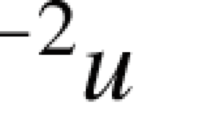Summary
An infinite-component wave equation is studied, which involves the nonlocal operatorW/p 2, whereW is the Pauli-Lubansky invariant. A method of quantization is proposed, which leads to a local commutation relation for the field. In particular a wave equation with a linear mass spectrum and without unphysical solutions is considered. A suitable choice of the Lagrangian gives rise to an algebra of conserved currents free of Schwinger terms in the time-time commutators.
Riassunto
Si studia un'equazione d'onda ad infinite componenti che contiene l'operatore non localeW/p 2, doveW è l'invariante di Pauli e Lubansky. Viene proposto un metodo di quantizzazione che dà luogo a una relazione di commutazione locale per il campo. In particolare si prende in considerazione un'equazione d'onda con uno spettro di massa lineare e che non ha soluzioni non fisiche. Un'opportuna scelta della lagrangiana dà luogo ad un'algebra delle correnti conservate senza termini di Schwinger nei commutatori tempo-tempo.
Резюме
Исследуется волновое уравнение с бесконечным числом компонент, которое содержит нелокальный операторW/p 2, гдеW представляет инвариант Паули-Любанского. Предлагается метод квантования, который приводит к локальному коммутационному соотношению для поля. В частности, рассматривается волновое уравнение с линейным спектром масс, и которое не имеет нефизических решений. Надлежащий выбор лагранжиана приводит к алгебре сохраняющихся токов без швингеровских членов в коммутаторах «время-время».
Similar content being viewed by others
References
Y. Nambu:Phys. Rev.,160, 1171 (1967);C. Fronsdal:Phys. Rev.,171, 1811 (1968);R. C. Hwa:Nuovo Cimento,56 A, 107, 127 (1968);L. O'Raifeartaigh:Proceedings of the Fifth Coral Gables Conference (1968);T. Takabayasi:Progr. Theor. Phys. Suppl.,41, 130 (1968).
G. Cocho, C. Fronsdal andR. White:Phys. Rev.,180, 1547 (1969);C. Fronsdal:Phys. Rev.,182, 1564 (1969);185, 1768 (1969).
P. Budini:Proceedings of the VI International School of Physics at Schladming (1967);D. Tz. Stoyanov andI. T. Todorov:Journ. Math. Phys.,9, 2146 (1968).
R. Casalbuoni, R. Gatto andG. Longhi:Lett. Nuovo Cimento,2, 159, 166 (1969); a more detailed work of the same authors is to be published on thePhys. Rev.
A. O. Barut andG. H. Mullen:Ann. of Phys.,20, 203 (1962); for a general discussion on the problem of handling higher order Lagrangians see alsoA. Pais andG. E. Uhlenbeck:Phys. Rev.,79, 145 (1950).
M. Ostrogradski (1850), as quoted inE. T. Whittaker:Analytical Dynamics (Cambridge, 1937), p. 265.
For the use of the invariant function\(\bar D(x)\) in a Lagrangian context, see also:J. R. Fox:Nucl. Phys.,15 B, 413 (1970);E. C. G. Sudarshan:Physics of complex mass particles, University of Austin preprint, January 1970.
SeeP. Roman:Introduction to Quantum Field Theory (New York, 1969). In the present paper we shall use the notations as in this book.
J. Schwinger:Phys. Rev.,82, 914 (1951);91, 713 (1951).
δμ(x,u) is defined by the equation\(\int\limits_\sigma {f(x)\delta ^\mu (x,y)d\sigma _\mu (x)} = f(y)\), and δ(x,y=n μδμ(x,y), wheren μ is the normal to the surface σ.
For a detailed study of the groupSL 2.c and of the invariant wave equations see:M. A. Naimark:Les représentations linéaires du groupe de Lorentz (Paris, 1962);I. M. Gel'fand, R. A. Minlos andZ. Ya. Shapiro:Representations of Rotations and Lorentz Groups and their Applications (London, 1963).
We consider only unitary representations since for a nonunitary representation ofSL 2.C vacuumlike solutions are absent.
It should be necessary to spend some words on the existence of a Lagrangian (Hermitian bilinear invariant form) for a givenSL 2.C representation, but the reader can find a detailed discussion of this point in ref. (4). Appendix B.
N. Mukunda:Phys. Rev.,183, 1486 (1969).
Author information
Authors and Affiliations
Additional information
Переведено редакцией.
Rights and permissions
About this article
Cite this article
Casalbuoni, R., Longhi, G. A nonlocal infinite-component wave equation with a physical mass spectrum. Nuovo Cimento A (1965-1970) 70, 329–343 (1970). https://doi.org/10.1007/BF02725378
Received:
Published:
Issue Date:
DOI: https://doi.org/10.1007/BF02725378




